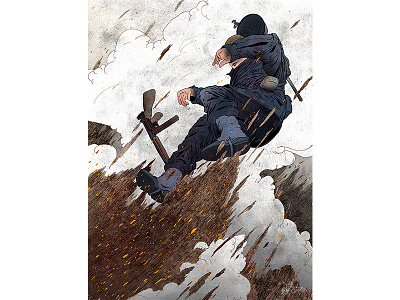Omaha
Illustration part of a series investigating the events that took place on D-Day, June 6, 1944, from surviving veteran testimonials.
The sea flowed red the morning of June 6, 1944. On the beach codenamed “OMAHA” was where the most blood spilled. In the fog of battle, moving chaotically up the beach, bobbing and weaving, trying to avoid machine gun fire and mortar explosions, as well as people falling, crawling and being blown around like leaves in the wind, created more obstacles than the already implemented defenses created by the Germans.
From the water to the enemy defencements was 300 yards of open sand with virtually no cover. The beachfront was full of anti-tank obstacles and telephone poles with mines strapped to the top to defend against landing crafts during high tide. Close to the dunes the Germans created intracity patterned minefields under the sand. Since most armor was destroyed or sunken in the channel, obstacles were still left in tack and forced the men to navigate the defenses with minor success.
John G. Burkhalter landed on Omaha Beach and instantly was swept up into the chaos of battle. Laying in the sand he witnessed incredible horror happening all round him, from explosions, to men being shot in half. As he turned to move up the beach further, a mortar shell landed nearby sending a team of men tumbling through the air in a mist of sand.
